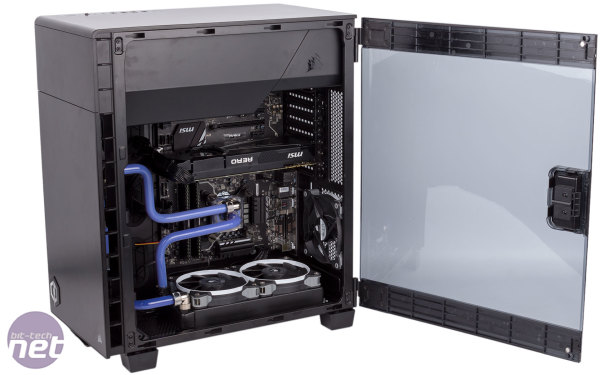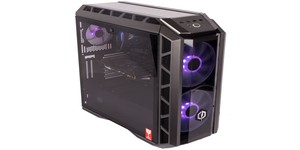CyberPowerPC Hyper Liquid 600 Review
September 30, 2016 | 16:37
Companies: #cyberpower #cyberpowerpc

Performance Analysis
Performance in the DirectX 11 tests, Fallout 4 and Unigine Valley, is similar to what we've seen from our own GPU testing. A GTX 1070 will net you smooth, playable frame rates at 1440p with Ultra settings, but you may need to drop down a notch or two to maintain an enjoyable experience at 4K. The DirectX 12 title, Total War: Warhammer, however, throws up some interesting results, in that this system is much faster than a GTX 1070 in our GPU test system. Our test system has more cores, but they run slower (4.2GHz versus the 4.5GHz here) and the memory is also a bit slower (2,667MHz against the 3,000MHz here). This is a good example of where extra CPU speed can help in games, especially in DirectX 12 titles where the idea is to better utilise the CPU. Once we get to 4K in this game, the GPU is now the limiting factor and performance is similar to what we saw with our test system.The CPU is overclocked such that it is fixed at 4.5GHz even when idle, so it's never wasting time switching states. This helps it achieve some excellent results in PCMark 8, including a chart-topping number in the Photo Editing workload. Terragen 3 and Cinebench also get great results for a quad-core CPU thanks to the Hyper-Threading. As noted before, however, the Core i5-6600K is a cheaper and better option if you're not running heavily threaded applications like these, as the benefits will be slim.
With the latest architectures from both Intel and Nvidia in play here, this is one very efficient system, with peak power consumption being less than 350W. Clearly, there's plenty of headroom to upgrade to SLI at a later date, or to save some cash with a lower wattage PSU.
The SSD offers standard SATA-grade performance in most tests, although a sluggish result in the Battlefield 3 workload suggests some weaknesses in the controller. Typically, though, difference between SATA SSDs are much of a muchness and near impossible to notice in day-to-day workloads.
Running the GPU and CPU at full load for a prolonged period saw the CPU hit a delta T of 51°C, with the core itself always kept below 70°C. The GPU, however, reached its temperature limit and was thus forced to throttle a little, although this isn't surprising given the cooler used. Noise from the trio of SP120 fans was a little on the loud side for our liking, especially given that the two on the radiator were running at full speed the whole time. The card also becomes audible under load with the fan spinning to over 2,000 RPM, although it's actually quieter than we were expecting.
Conclusion
As ever, making an assessment of a pre-built system starts with tallying up the raw cost of the components used were you to buy them yourself. Having a water-cooling loop makes this tricky, but we estimated a rough raw cost of around £1,550 for everything you get here. This means you're paying around £200 for the build service and warranty and the question is whether or not CyberPowerPC have done enough to justify this.The three year warranty with only one month collect and return is a bit basic for our liking and there are competitors with better default options. As for the build service, the Hyper Liquid 600 we were presented with certainly struck us as being very professionally put together. The cable routing is excellent, the BIOS settings were properly applied and saved and the water-cooling loop and RGB lighting look great. The water-cooling is especially important to consider, because putting together a rigid tubing loop, even one that's relatively basic like this, does involve considerable time, effort and skill that many will be keen to avoid. It may also occur additional costs for the tools required to cut and bend the tubes. It's certainly not something all system integrators offer, and frankly it looks fantastic and gives CyberPowerPC an edge in a somewhat crowded market.
Component selection is another important issue, although we shan't focus too much on it here since in most instances it's easy to change the configuration to match your needs. That said, there are some concerns with this system. For example, we're not convinced it's going to stay dust free for very long, which risks spoiling the great looking interior. The approach to cooling also strikes us as odd. Water-cooling is about maximising performance and minimising noise, and not taking advantage of the case's fan controller to give users the flexibility to balance these two options seems silly. As a result, the system was a bit too loud for our liking, especially when idle. This isn't helped by the reference-style cooler on the graphics card, and this is one element of the configurator that you can't change – the only other GTX 1070 is a custom water-cooled one which is considerably more expensive; it would be nice to have some better air-cooled options as many of these are extremely quiet indeed.
All told, the Hyper Liquid 600 still impressed us, mainly for its great use of rigid tubing, which also makes the easy upgrade path to SLI enabled by the PSU and motherboard all the more important, as no one wants to be pulling a rigid tube loop apart to make an upgrade. The concerns with this specific build outlined above mean we can't reach for our top award, but the professional build quality stands out enough for a Recommended.


MSI MPG Velox 100R Chassis Review
October 14 2021 | 15:04










Want to comment? Please log in.